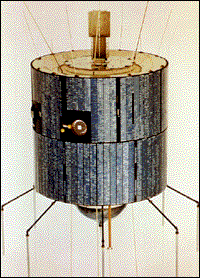 ATS-3 prelaunch | |
| Mission type | Weather Communications Technology |
|---|---|
| Operator | NASA |
| COSPAR ID | 1967-111A |
| SATCAT no. | 3029 |
| Mission duration | 34 years (final) 56 years, 11 months, 7 days (in orbit) |
| Spacecraft properties | |
| Bus | HS-306 |
| Manufacturer | Hughes |
| Launch mass | 365.0 kilograms (804.7 lb) |
| Start of mission | |
| Launch date | November 5, 1967, 23:37:00 UTC[1] |
| Rocket | Atlas SLV-3 Agena-D |
| Launch site | Cape Canaveral LC-12 |
| End of mission | |
| Deactivated | 2001 |
| Orbital parameters | |
| Reference system | Geocentric |
| Regime | GSO |
| Semi-major axis | 42,241.0 kilometres (26,247.3 mi) |
| Eccentricity | 0.00043 |
| Perigee altitude | 35,723 kilometers (22,197 mi) |
| Apogee altitude | 35,862 kilometers (22,284 mi) |
| Inclination | 6.92 degrees |
| Period | 23.93 hours |
| Epoch | January 21, 2014, 11:54:19 UTC[2] |
Applications Technology Satellite 3, or ATS-3, was a long-lived American experimental geostationary weather and communications satellite, operated by NASA from 1967 to 2001.[3] It was at one time reputed to be the oldest satellite still in operation.[4] As of 1995[update], NASA referred to the ATS-3 as "The oldest active communications satellite by a wide margin."[5]
On November 10, 1967, ATS-3 took NASA's first color photo (digital image mosaic) of the full-disk Earth, which was subsequently used on the cover of the first Whole Earth Catalog.
- ^ McDowell, Jonathan. "Launch Log". Jonathan's Space Page. Retrieved January 24, 2014.
- ^ "ATS 3 Satellite details 1967-111A NORAD 3029". N2YO. January 21, 2014. Retrieved January 24, 2014.
- ^ "ATS | Science Mission Directorate". science.nasa.gov. Retrieved October 27, 2016.
- ^ "Technology". solarstorms.org. Archived from the original on September 28, 2006. Retrieved November 17, 2012.
- ^ Glover, Daniel R. (1997). "Chapter 6: NASA Experimental Communications Satellites, 1958–1995, SP-4217 Beyond the Ionosphere". In Butrica, Andrew J. (ed.). Beyond The Ionosphere: The Development of Satellite Communications. NASA.